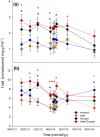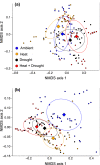Hotter droughts alter resource allocation to chemical defenses in piñon pine
- PMID: 34657177
- PMCID: PMC8591002
- DOI: 10.1007/s00442-021-05058-8
Hotter droughts alter resource allocation to chemical defenses in piñon pine
Abstract
Heat and drought affect plant chemical defenses and thereby plant susceptibility to pests and pathogens. Monoterpenes are of particular importance for conifers as they play critical roles in defense against bark beetles. To date, work seeking to understand the impacts of heat and drought on monoterpenes has primarily focused on young potted seedlings, leaving it unclear how older age classes that are more vulnerable to bark beetles might respond to stress. Furthermore, we lack a clear picture of what carbon resources might be prioritized to support monoterpene synthesis under drought stress. To address this, we measured needle and woody tissue monoterpene concentrations and physiological variables simultaneously from mature piñon pines (Pinus edulis) from a unique temperature and drought manipulation field experiment. While heat had no effect on total monoterpene concentrations, trees under combined heat and drought stress exhibited ~ 85% and 35% increases in needle and woody tissue, respectively, over multiple years. Plant physiological variables like maximum photosynthesis each explained less than 10% of the variation in total monoterpenes for both tissue types while starch and glucose + fructose measured 1-month prior explained ~ 45% and 60% of the variation in woody tissue total monoterpene concentrations. Although total monoterpenes increased under combined stress, some key monoterpenes with known roles in bark beetle ecology decreased. These shifts may make trees more favorable for bark beetle attack rather than well defended, which one might conclude if only considering total monoterpene concentrations. Our results point to cumulative and synergistic effects of heat and drought that may reprioritize carbon allocation of specific non-structural carbohydrates toward defense.
Keywords: Drought; Heat; Ips confusus (piñon engraver beetle); Monoterpenes; Non-structural carbohydrates.
© 2021. The Author(s).
Conflict of interest statement
The authors declare that they have no conflict of interest.
Figures








References
-
- Adams HD, Collins AD, Briggs SP, Vennetier M, Dickman LT, Sevanto SA, Garcia-Forner N, Powers HH, McDowell NG. Experimental drought and heat can delay phenological development and reduce foliar and shoot growth in semiarid trees. Glob Change Biol. 2015;21:4210–4220. doi: 10.1111/gcb.13030. - DOI - PubMed
-
- Allen CD, Macalady AK, Chenchouni H, Bachelet D, McDowell N, Vennetier M, Kitzberger T, Rigling A, Breshears DD, Hogg EH, Gonzalez P, Fensham R, Zhang Z, Castro J, Demidova N, Lim J-H, Allard G, Running SW, Semerci A, Cobb N. A global overview of drought and heat-induced tree mortality reveals emerging climate change risks for forests. For Ecol Manag. 2010;259:660–684. doi: 10.1016/j.foreco.2009.09.001. - DOI
-
- Allen CD, Breshears DD, McDowell NG. On underestimation of global vulnerability to tree mortality and forest die-off from hotter drought in the Anthropocene. Ecosphere. 2015;6:1–55. doi: 10.1890/ES15-00203.1. - DOI
MeSH terms
Grants and funding
LinkOut - more resources
Full Text Sources

